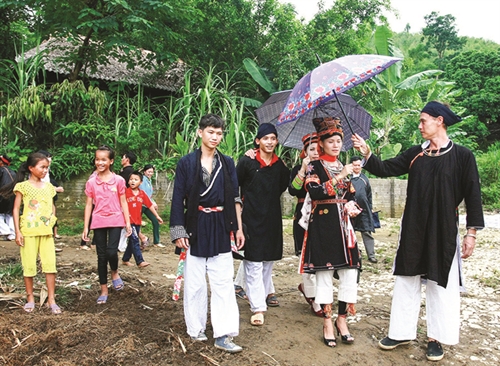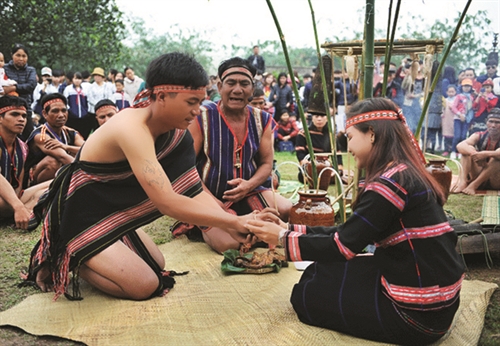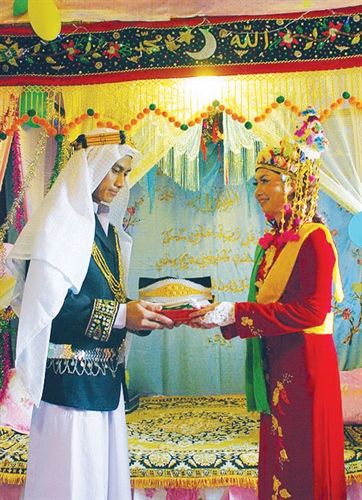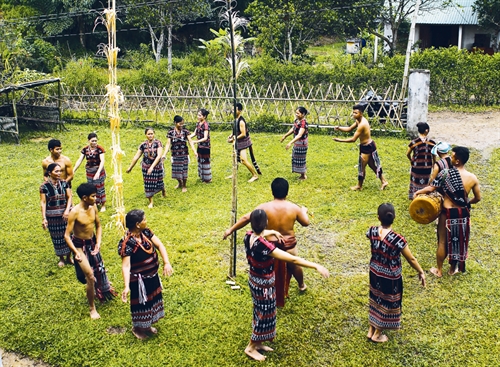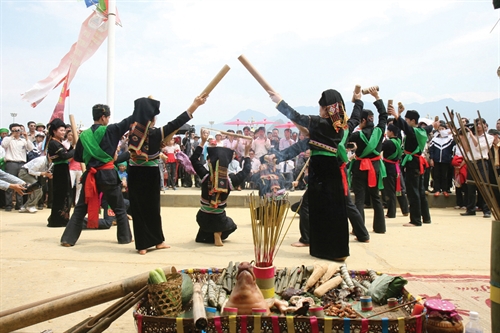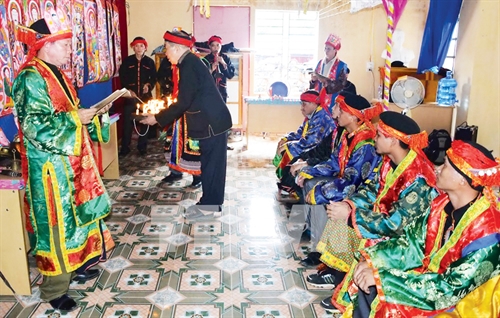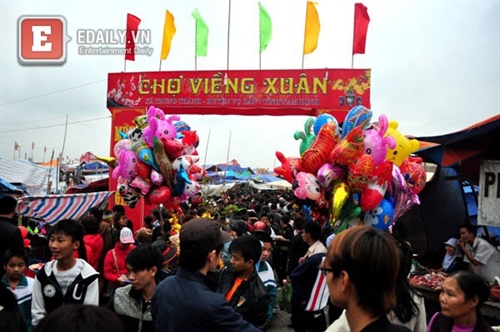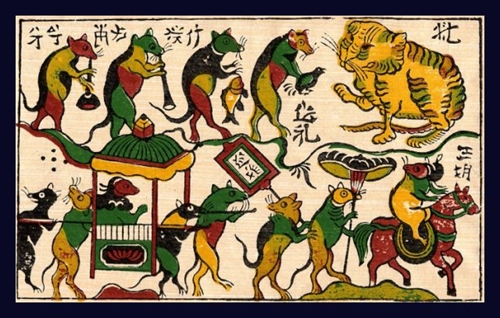>>The "Dao" ethnic minority - its customs and practices
Ta Thi Tam
Ethnology Institute
The Dao, one of 54 ethnic minority groups in Vietnam, immigrated into the country in the late 17th century, living in areas bordering Laos and China with a population of over 750,000.
Like other groups, the Dao has its unique tradition for celebrating Tet, the Vietnamese lunar new year festival. On the 28th of the twelfth lunar month, a Dao family slaughters pigs to prepare food for Tet. The next day, it makes banh chung, an indispensable Tet offering to ancestors, by boiling for over 10 hours sticky rice filled with green bean paste and pork and wrapped in banana leaves in square shape.
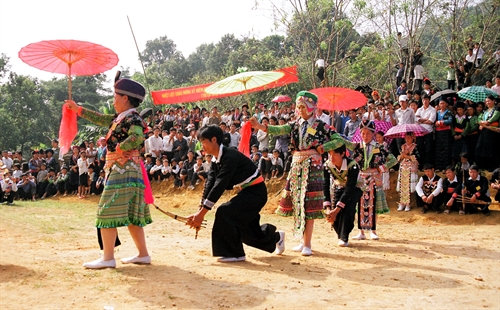 |
| Dao people dances to celebrate the new year__Photo: Internet |
Tet of the Dao lasts from the 25th of the last lunar month to the 15th of the first lunar month during which a family invites ancestors to return home to enjoy Tet with their descendants, thanking them for protecting the family throughout the old year and praying for their support for the family’s health and prosperity in the new year.
To prepare for Tet festivities, young men practice dances while girls make new indigo clothes for family members to wear during Tet.
On the 30th, all family members wake up early to clean up the altar and offer black banh chung to their ancestors, which has its color by soaking sticky rice in a liquid of burnt forest leaf powder. After the offering ceremony, the family cleans the altar again and make banh mat (treacle cake) for offering on the next day. The family also boils a big bucket of water for all members to take a bath on the new year’s Eve as the Dao believes everybody must be clean to welcome the new year.
Before the new year’s Eve, the family decorates the altar, placing 5-10 whole sugar canes around the altar and sticking flowers, fruits and votive papers to banh chung and banh day (round sticky rice cake filled with green bean paste) on the altar in the hope of gaining its ancestors’ support for a new year of peace and prosperity.
Men in the family cut pink papers into V letter-shaped pieces of 20 x 10 cm size and hang them at the altar, entrance doors, breeding facilities and farming tools, showing the family’s gratitude toward their ancestors and signaling the approach of a new year when everybody can take a new year break.
According to Dao custom, a woman is not allowed to burn incenses on the altar on the Eve and must ask a cousin to do so if the family does not have a man. A Dao altar must be lit by kerosene lamps throughout the Eve, the 1st and the 15th of the new year as fire symbolizes warm, prosperity and peace. The group keeps a vegetarian diet and does not kill animals on the 1st of the new year.
Early morning of the 1st, all family members gather in front of the ancestor altar of the clan head. After a ritual to inform ancestors of the new year celebration, with knives and hoes in their hands, family members go out of the house through the main entrance gate to a peach or plum tree. The clan head raises the knife and says angrily to the tree: “Why don’t you yield fruit even though I have tended you? I will cut you down now.” Another person then pleads in the name of the tree: “Please do not cut me down, I will surely yield fruit this year.” The clan head then lowers his voice “Ok, but remember to keep your promise.” And he hoes the soil around the tree and cuts a branch of flower to put on a pair of banh day on the altar. Others quickly pick up some stones outside the clan head’s house and put them under the altar to be regarded as gold and silver.
After this ritual, family members join other villagers to celebrate the new year in the house of the village patriarch.
An original event of the Dao’s Tet is the dancing festival which is also held in the house of the clan head at around 9 am on the 1st and 2nd. To prepare for this festival, before Tet, clan members help the head decorate the ancestor altar, which is placed in the part facing the main kitchen, with colorful paper pictures showing images of the sun and crest. On the two sides of the altar are hung parallel sentences written on pink papers, praying for peace and prosperity and showing gratitude to ancestors.
Opening the dancing festival, under a sorcerer’s instruction, a group of young men perform 14 dances to lead the way and build a bridge for ancestors to return home for Tet. To greet ancestors, dancers must dance on only one leg and with their heads lowered and their forefingers raised high. Then comes a dance to invite fairies to descend on earth, depicting stocks flying high and far and then looking for perching places. And finally is a dance to welcome deities, which is illustrated with deliberate and powerful tiger steps.
Following these dances to welcome deities and ancestors, all clan members perform a dance for the procession of the ancestor statue, an original wooden sculpture work of the red Dao. The statue is around 25 cm long carved with beautiful ancient costume patterns. In the right hand of the statue is a badge showing the name of the forefather.
During the year, this statue is wrapped in white cloth and only when Tet comes that the family baths and changes a new scarf for the statue. The water for bathing is distilled from aromatic spices through a strict process, deeply reflecting Vietnamese ancestor worship belief. After the bathing ritual, family members perform a cock sacrifice dance in which the sorcerer and three young men dance with a live cock in their hands, putting the cock on their heads and then on their shoulders before sacrificing it to ancestors. Closing the ritual is a flag dance.
Another typical activity of the Dao during Tet is responsive love singing which gives chances for not only young men and women to show their love but also for couples who cannot marry one another to remember their love memories. Before Tet, villages exchange letters requesting nomination of singers for their villages. The letters are enclosed with three rolls of pipe tobacco and three pairs of coins as an offering to village patriarchs for permission for young people to participate in the event.
From the 2nd through the 10th of the new year, this singing event takes place everywhere, which can last throughout the night and from one day to another.
During Tet, the Dao has some special taboos. On the 1st of the new year, Dao people are not supposed to wear white clothes as white is believed not to be favored by ancestors.
From the 1st to the 12th, Dao people have the taboo to dump rubbish, which is only swept into a corner of the house. Rubbish disposal during Tet is believed to deny the family of good fortune throughout the year. After Tet, the family will choose a good date to burn all rubbish in a place at least 100m away from the house.
Tet reflects the Dao’s old cultural values and deep humanity through its ancestor worship rituals. In some places, the Dao venerates chicken as its totem which is believed to protect the existence and development of the group.-
